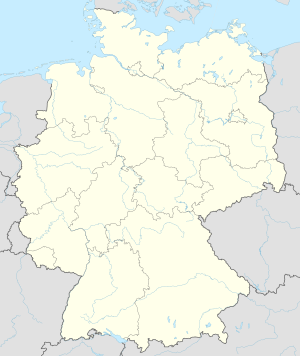Dog stable bridge
Coordinates: 51 ° 7 ′ 9 ″ N , 13 ° 55 ′ 35 ″ E
| Dog stable bridge | ||
|---|---|---|
| Looking downstream | ||
| use | Road bridge | |
| Convicted | Schlossstrasse | |
| Subjugated | Big Röder | |
| place | Radeberg , Germany | |
| construction | Arch bridge | |
| building-costs | 203 Thaler 12 Groschen | |
| start of building | 1781 | |
| completion | 1781 | |
| planner | Master mason Jähne, Radeberg | |
| location | ||
|
|
||
The Hundestallbrücke is a stone arch bridge over the Große Röder in the Saxon town of Radeberg . The building is a listed building and is located directly next to Klippenstein Castle .
history
The oldest surviving tradition of a Röder bridge in the form of a wooden path at Klippenstein Castle dates back to the 16th century. The traffic on the road from the castle and office Radeberg to Wallroda and on to the Vorwerk Kleinwolmsdorf, which until 1665 belonged to the castle and office Radeberg, crossed the Große Röder through a ford . The Duke of Saxony and later Elector Moritz was from 1543 to 1546, the castle Radeberg hunting lodge Klippenstein rebuild. This also required the construction of accommodation and functional buildings for the court , for example for the hunters. At the latest for Christian I , Elector of Saxony from 1586 to 1591, the keeping of numerous hunting dogs has been handed down. The dog stalls created for this purpose were located on the left side of the Großer Röder and could only be reached from the castle through the ford or on foot via a wooden path.
When the Radeberg bailiff Ernst Ludwig Langbein, the father of the poet August Friedrich Ernst Langbein , bought the fiefs of the palace on the left Röder side after the Seven Years' War in the 18th century and had his terraced Langbein garden laid out on them, the construction workers came across the remains of the former walls Dog stalls and hunter quarters. Since the simple wooden paths over the Große Röder were destroyed several times as a result of frequent floods and the growing agriculture above the left bank of the Röder required a safe crossing of the Röder, bailiff Langbein arranged for a stone bridge to be built, also for easier access to his gardens. The voluntary contributions raised by the field owners belonging to the Burglehn brought only 78 thalers. To cover the total costs of around 203 thalers, the field owners had to borrow 18 groschen per bushel of land on Langbein's instructions. In May 1781, the Radeberg master mason Jähne began building the bridge, which was completed in the same year.
The name Hundestallbrücke is due to this fact. The Grosse Hundestallweg also reminds of the dog stalls . In the vernacular, the place at the bridge was referred to as near the dog stable , the areas to the left of the Röder were called dog kennels .
Building
location
The Hundestallbrücke crosses the Große Röder east of Klippenstein Castle near the Owl Tower. A little upstream is the castle mill and the access to the Hüttertal nature reserve , opposite on the left side of the Großer Röder is the Langbeinsche Garten on the left of the Großer Hundestallweg.
execution
The Hundestallbrücke is an arch bridge made of sandstone and granite , which leads in a single arch over the Große Röder. The route over the bridge is limited by low stone walls on which metal railings are attached. At the beginning of the 2000s, the bridge was extensively renovated, whereby the original shape and design from 1781 to the present day have been preserved. Among other things, the abutments and the bridge foundations were secured, traces of previous renovation actions removed and the bridge repaired in accordance with the Saxon Monument Protection Act .
See also
- List of bridges in Radeberg - Overview of all bridge structures in Radeberg and districts
Web links
Individual evidence
- ↑ List of cultural monuments of the city of Radeberg, section Radeberg. (PDF; 116 kB) Accessed September 12, 2014 .
- ↑ a b Friedrich Bernhard Störzner : The castle of Radeberg , in: What the home tells . Arwed Strauch, Leipzig 1904, pages 13–15. ( Digital full-text output in Wikisource )
- ^ Thieme / Knobloch: Radeberger Chronik 1550–1839 . Museum Schloss Klippenstein Radeberg. Archive no. 00003476
- ↑ Chronicle of Klippenstein Castle. Museum Schloss Klippenstein, accessed on April 25, 2018 .
- ↑ a b Rudolf Scheibe: “Wau!” - old bridge. In: Sächsischer Bote, edition June 12, 2013 ( online ( memento from April 8, 2014 in the web archive archive.today )).
- ↑ City council resolution to renovate the Hundestallbrücke bridge. City of Radeberg, accessed on September 12, 2014 .


